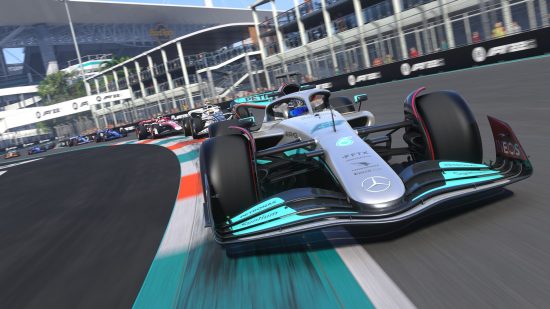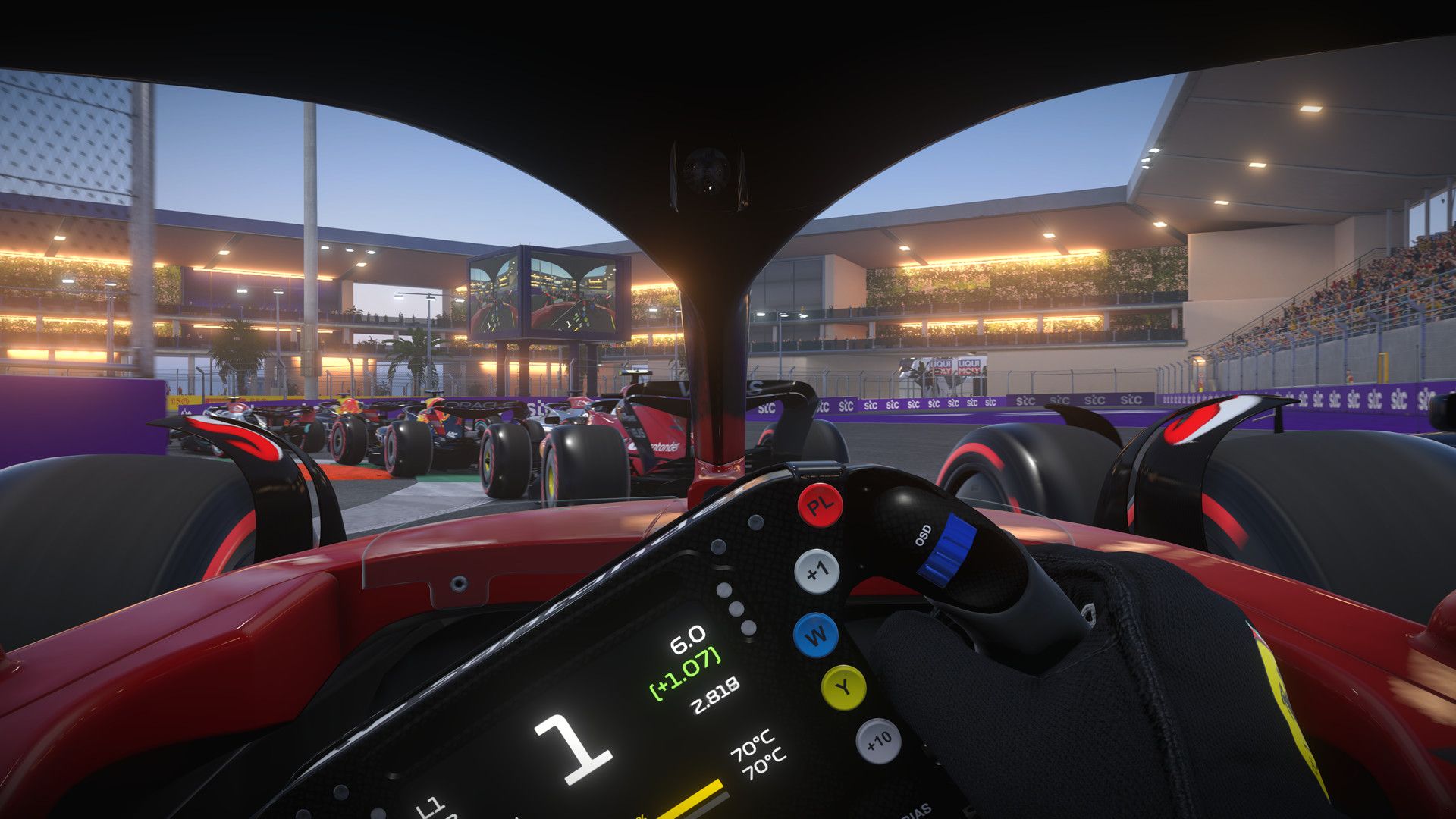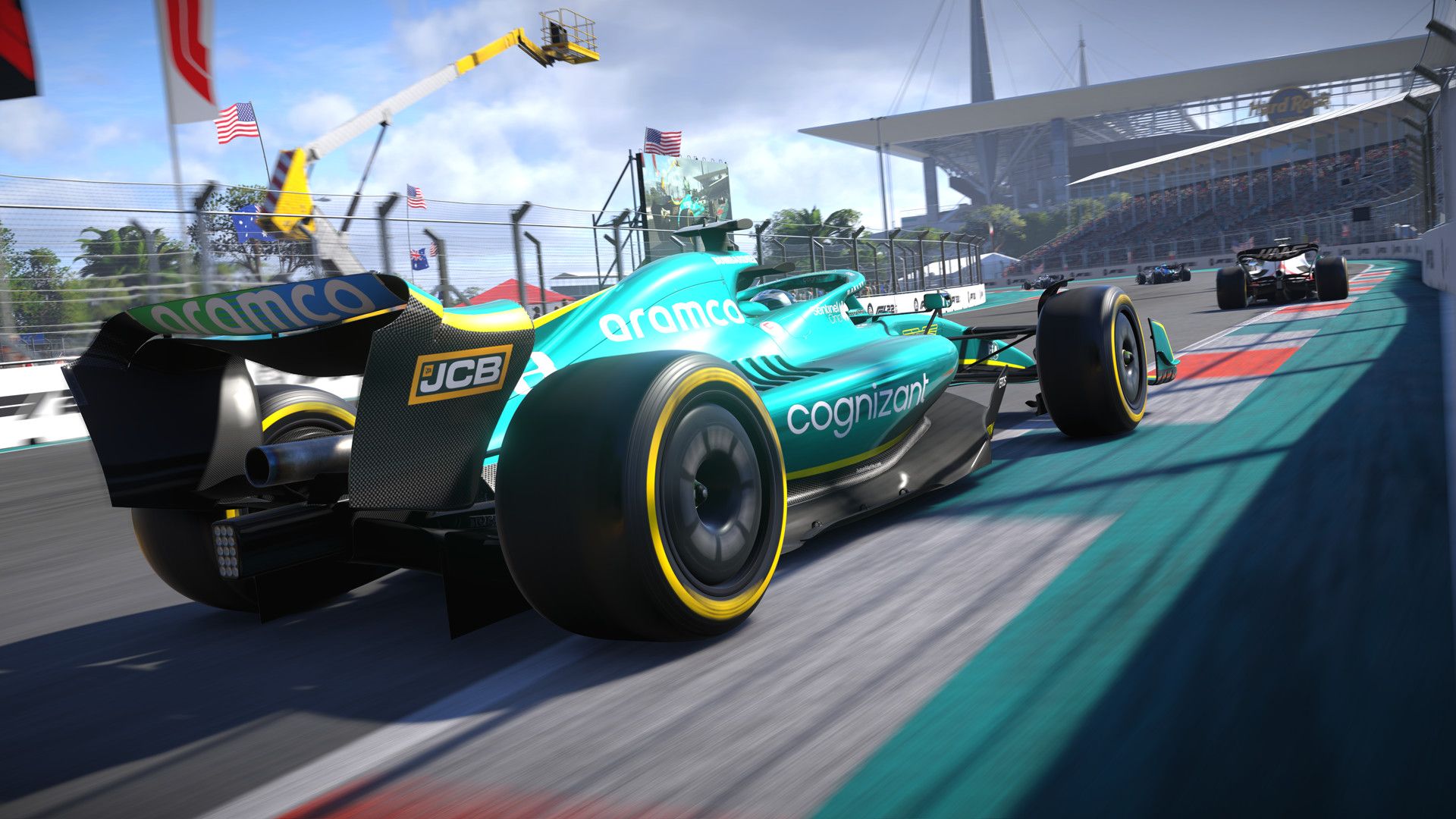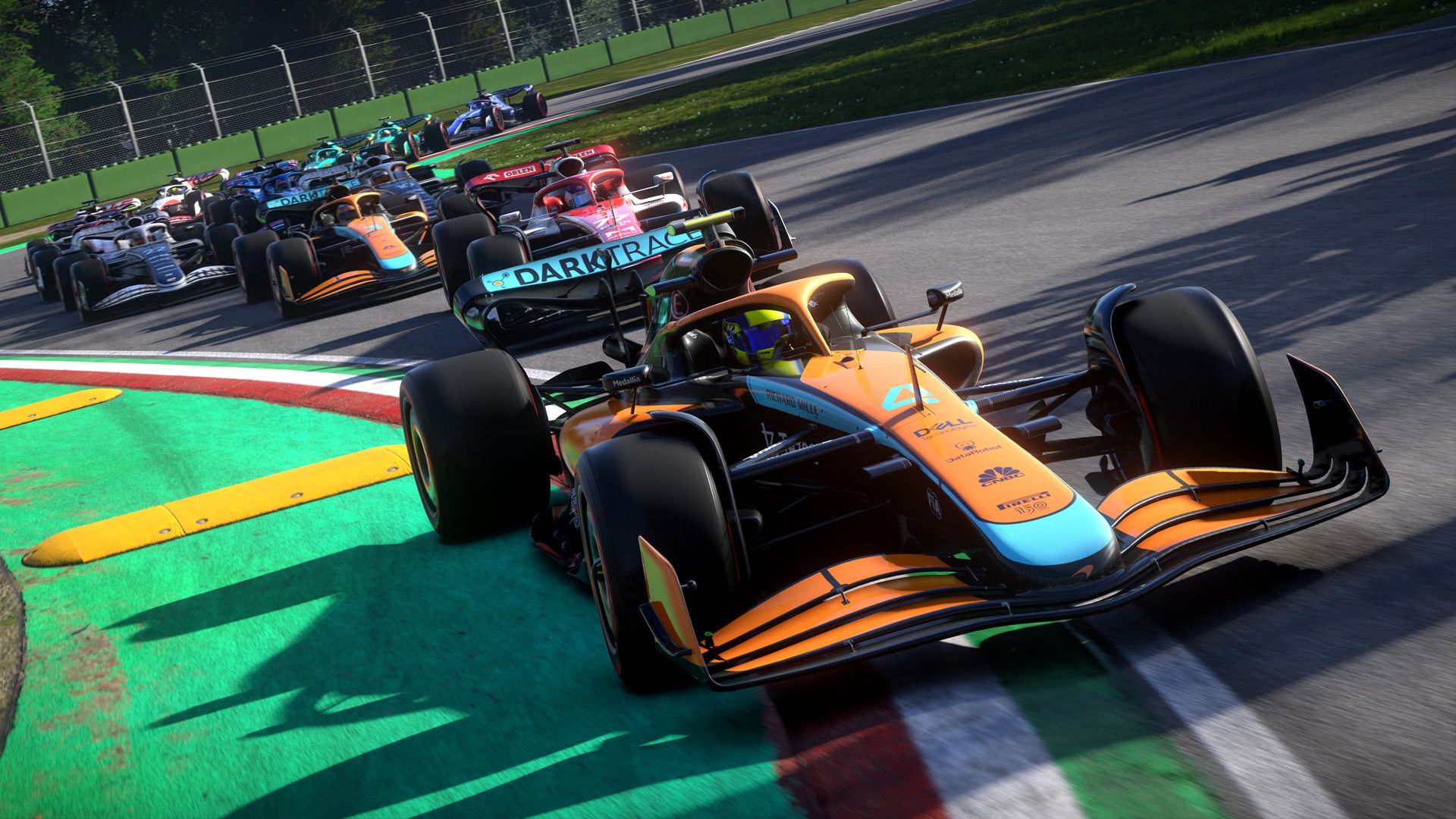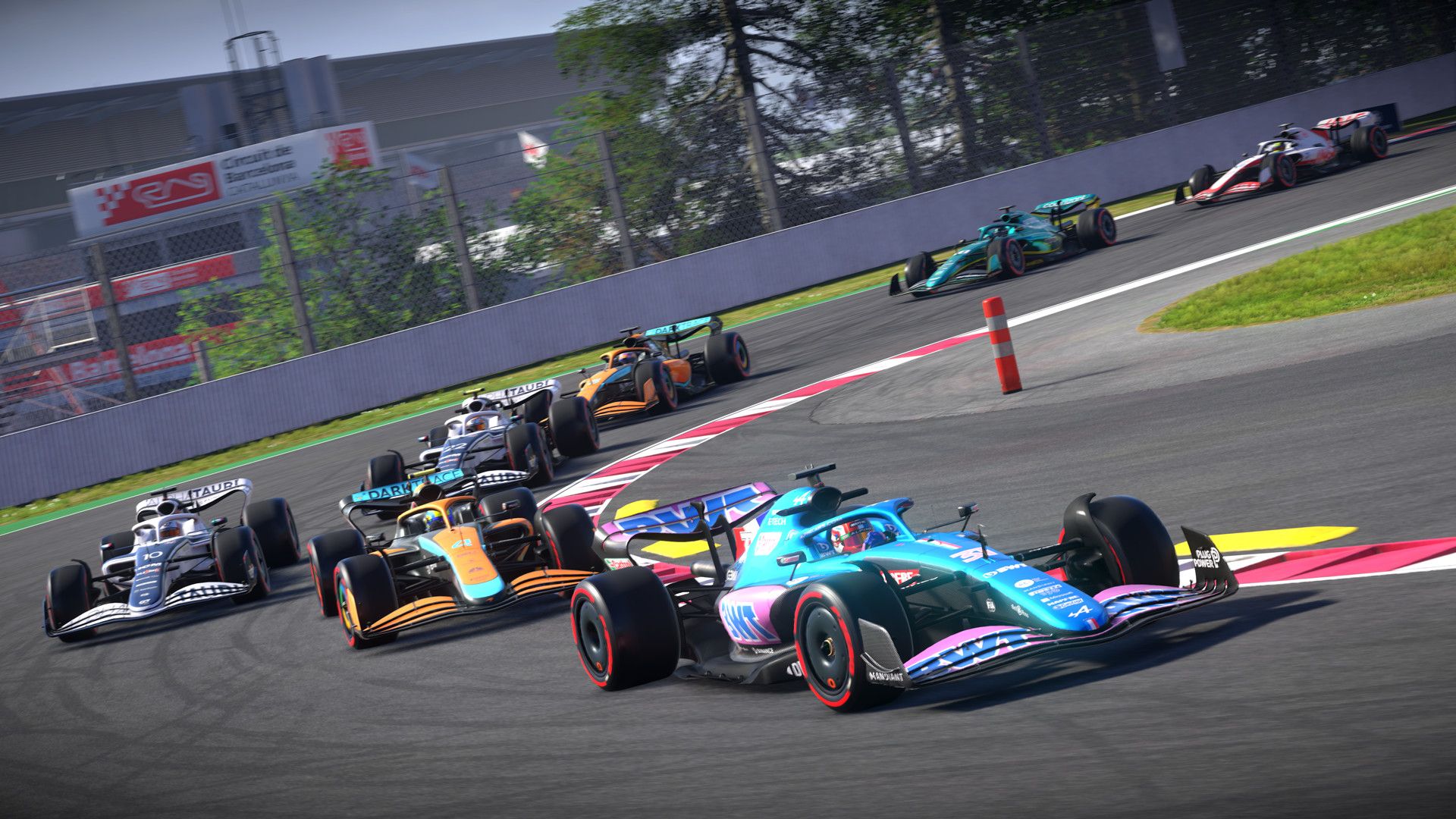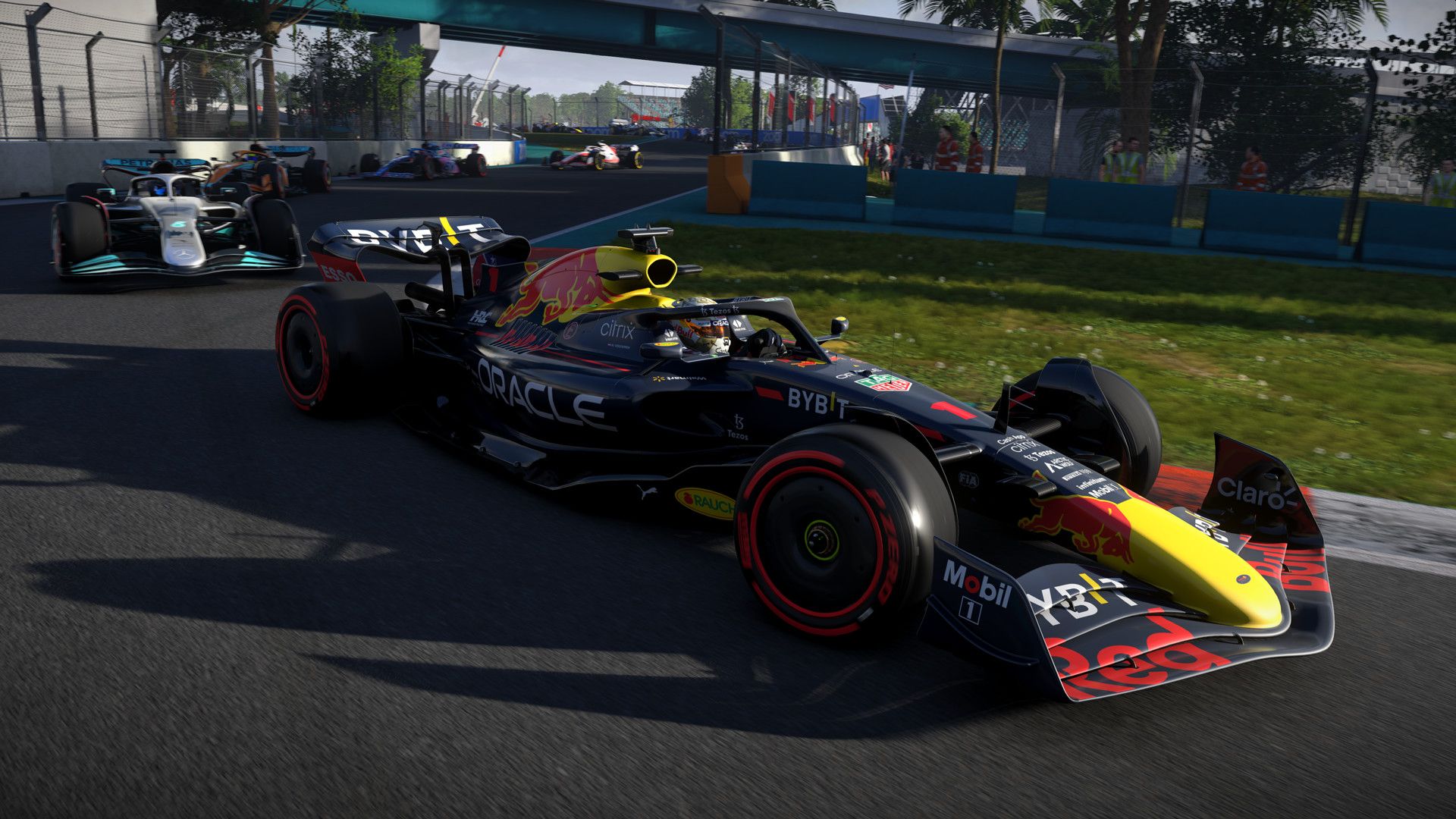Our Verdict
Built on the foundations of several fantastic games, and those qualities remain - but you already own them. F1 22 simply doesn’t offer enough for a full-price purchase.
The essence of our F1 22 review hits me on turn eight at Canada. Two seasons into my career, making my step up from F2 to join Alfa Romeo in the big leagues for 2022, I’m battling for 13th with Kevin Magnussen’s Haas. It’s a grey day in Montreal, and we don’t have the pace we need because 100% of our upgrades through the season have failed development and needed re-developing. I have a train of cars behind me who clearly have better pace, but whose governing AI won’t quite let them overtake. It occurs to me, as I lose another two tenths to Kevin on the corner exit struggling for traction: I’m not having much fun.
I could be making it easier on myself, of course. F1 22, like all previous series entrants, lets you select AI difficulty, toggle a number of assists, and start your career at a top team. So I could in theory be sitting in a Ferrari smoking the field of severely diminished AI drivers by 20 seconds. And indeed, in the interest of a fair review I’ve done that too, in quick races. It’s just… doing that wasn’t much fun either.
But let’s start with the basics. In addition to new cars reflecting the real sport’s significant 2022 regulation changes, the new Miami circuit and some ray tracing effects on PC, F1 22 adds driveable road cars, and revamped main menu and online multiplayer lobby menus. These are now 3D environments, set in your home, where you can customise the furnishings and show off in whatever road cars or clothing items you’ve unlocked.
Road cars are effectively a straight swap for the classic cars in previous games. Where before you might be invited to special classic car events between races in career mode, now you’re asked along to complete Pirelli Hot Laps challenges in the likes of a Mercedes AMG-GT or a Ferrari Roma. These challenges vary from drift events to cone courses and award you gold, silver, or bronze medals for beating time limits.

These events feel oddly limited and don’t include simple all-out races, and although the cars’ handling itself is passable enough, there’s not enough substance to it to hold your attention. They don’t squirm around under traction or try to wrestle their back ends free from your control, and crucially you don’t get much of a sense of shifting weight. Such a thing would, of course, be a massive departure from the game’s underlying physics model, since F1 cars are incredibly stiff things with precious little weight transfer through corners. It would be asking a lot to summon an all-new physics model that convincingly depicts a road car’s behaviour, certainly, so I can understand why F1 22’s Aston Martins, Ferraris, McLarens, and Mercs don’t feel like Assetto Corsa Competizione’s.
However, it’s less dismissable and more disappointing to see that your hands don’t even move on the wheel in cockpit cam. In the end these Pirelli Hot Laps events are a sideshow, so F1 22 doesn’t live and die on your enjoyment of them. Still, it’s the headline feature of a new release in an annualised sports series, and one in which new headline features are thin on the ground, so on those terms it does matter.
Onto the revamped menus. This is called F1 Life in the game, and that’s a bit of an upsell. I love the idea of the series branching out into a driver’s lifestyle off the track, and hold firm in my fantasy of a Sims/racing sim hybrid, but this isn’t even a tentative step in that direction. Instead, it’s a main menu overhaul which shows your avatar lounging about on customisable furniture near some of the aforementioned road cars you’ve bought and placed around your luxurious pad. When you’re in a multiplayer hub, other avatars enter your F1 Life and gather to admire your, ahem, swag. There’s a trophy room in which to showcase your achievements, but between you and me this feels very much more about getting you to buy Pitcoins and spend them on Puma tracksuit bottoms than immersing you in an F1 driver’s lifestyle.
A quick word on that. There currently aren’t many outfit options to buy, and what options there are look pretty basic – T-shirts, joggers, shorts, the obligatory Beats headphones, and some hats. I’d expect that there’ll be a lot more to come in post-release content. While these items can be purchased via Pitcoins which you can earn through in-game actions, you can also buy Pitcoins with real cash. So, speaking as a series-long fan with hundreds of hours in each game and a longstanding fantasy of expanded lifestyle elements, F1 Life is a bit of a bust for me. It really does just feel like a customisable 3D menu.
Happily, F1 22 fares better on the track. It’s done a wonderful job of simultaneously simulating TV coverage of the sport and making you feel like an insider within it for years now, and that’s just as true as ever in this game. Particular attention to detail has evidently been paid to incidental pre-race shots in this game, including a new spectator mode warm-up lap and fresh commentary from familiar voices from Sky Sports coverage.
The cars feel different, most notably in the way they can handle going over bumpy curbs now without losing ground effect downforce and spinning out (which is actually a bit odd given the 2022 regs dictate that the new cars get so much more of their downforce from underfloor parts) and their twitchiness at high revs and low gears on corner exits.
These handling changes mean you can certainly apply a huge amount of transferable skills from previous F1 incarnations, but can’t depend solely on old muscle memory to set purple sectors. With the easier input modulation of a wheel, you can really sink your teeth into these new twitchy cars, babying them out of low-speed corners with a soft foot and smooth hands. While there’s no observable porpoising effect here, it feels sufficiently different enough to be gripping. Wandering out onto the extremes of track limits again like a wannabe sim racer, knowing that catching a whiff of rumblestrip isn’t going to Mazepin you round 180 degrees, is liberating. Spinning after you got too ambitious on worn hards coming out of a hairpin is heartbreaking.
Truthfully I’m not sure what to make of driver AI yet. I need more track time with them. During my first few races in F2 there were several collisions and mistakes that happened in front of me, independent of my positioning, and they looked really impressive. Three cars fanning out in a braking zone and squeezing each other wide, that kind of thing – the incidents GRID does so well. But in F1, drivers seem much happier to remain in a boring procession and I’ve witnessed far fewer AI incidents.
That in itself isn’t a negative – although it’d be a step forward to see more convincing AI driver mistakes – but what did impact my enjoyment was AI drivers’ reluctance to overtake.
This has been a problem for years – you make up 11 places on the first lap because they’re all driving round like they’re on ice and face the death penalty for overtaking. Then on lap two they magically find their actual pace again, but because you snuck your Williams in front of them a lap ago, the Mercs and McLarens are stuck behind you despite their pace advantage. They make it through during long DRS zones, but you can nearly always outbrake them again, and it’s almost unheard of for them to send one under braking. As a result, in longer races you end up holding up a traffic jam of cars and then lose out heavily in pit stops. And because they input their throttle and brakes with incredibly fast blips – watch their inputs in benchmark mode – they’re impossibly smooth out of corners, but always need more braking distance. As a result you generally lose time to them in most corner exits and then gain it back on the brakes.
Back to the grey weekend in Montreal, where I’m going all-out for P12 with a man who once invited a fellow racer to suck his balls live on air. It strikes me that however invested I am in improving the car and earning championship points, I’m not actually having a tremendous amount of fun.
And despite F1 22’s other previously detailed issues, the lacklustre new features and odd AI quirks, I put it down to two specific factors. Only one of them is the game’s fault, explicitly.
The first is the gamepad control. I just don’t enjoy racing with a pad, because modulating the throttle and brakes is so crucial to this year’s handling model, and so difficult to do on a device with a tiny range of modulation. Traction control is also vital this year, so I can either turn TC on and lose buckets of time to an overzealous assist, or try to manage it with a gamepad trigger where 25% throttle and 50% throttle are about 2mm apart. Similarly, steering feels stiff and sluggish using a controller, and the kind of steering inputs you tend to make with one require even better throttle control to keep your traction and momentum than with a wheel.
The second – and this one isn’t F1 22’s fault so much as the 11 previous games and the nature of the modern games industry – is the cumulative fatigue of having been through this experience so many times before in previous iterations, and having so little meaningful new content in F1 22 to relieve it. It’s still fantastic to have all the cars, tracks, driver likenesses, commentary, a deep career mode, and comprehensive online options. But we’ve been treated to them many times, and spent many, many hours in those previous ecosystems. We’re bound to find ourselves dulled to their charms eventually.
And that makes this a difficult game to review. Because it’s a member of a series that includes some of the best racing games around, which only two entries ago I loved and made some genuinely impressive annual changes. Some of those features are still here: an in-depth car development system, a whole team creation and management mode with plenty of visual customisation options, the entire F2 grid to race in quick events or begin career mode in.
Some are gone too, like classic cars and the cinematic story mode introduced in last year’s Braking Point. But it’s not just their omission affecting my mood as I play. It’s the lack of forward momentum, the feeling that I’m playing a game I already own and put hundreds of hours into last year and the year before that, with updated cars and tracks and not enough else of real substance.
